Smart Glasses, often colloquially referred to as “data glasses” in German, created a lot of hype a few years ago. In the meantime, the so-called smart glasses are being used by more and more companies in service and support, but also in manufacturing or logistics, and are increasingly becoming a digital tool for the industry. Especially for applications in remote service, the use has increased significantly since a year ago. With the help of a smart glass, an expert can be virtually on site with the customer and look “over his shoulder” during complex repairs.
Some suppliers have recognised the potential and the market now offers numerous smart glasses; but not all of them are suitable for everyday use in harsh industrial environments. Good quality and a mature operating concept must be a given. Reason enough to give you an overview of the “best smart glasses” that the market currently has to offer.
Difference between binocular and monocular smart glasses
In principle, there are two different types of smart glasses, namely models with a binocular display, also called a stereo display, and models with a monocular display.
With binocular smartglasses, digital information is displayed in both eyes with depth (3D). This allows the implementation of so-called see-through AR applications, i.e. content can be displayed with a correct spatial reference that appears slightly transparent, like holograms. The display adapts to the viewing direction. If the user looks into the distance, the display appears larger at the same time. Binocular smart glasses are particularly suitable for immersive AR applications in which the main focus is on projecting content directly into the real world. Content can, for example, be virtual panels that are displayed directly on the respective machines in order to quickly and easily read important key figures or status messages of a machine.
In monocular AR, on the other hand, digital information is displayed on one eye without depth (2D), i.e. the camera image and the content augmented within it are displayed in a small floating window. Monocular smart glasses are particularly suitable for applications whose goal is to display helpful information to the user while providing an unrestricted view of the machine or system. A typical application is remote assistance. Via the monocular Smart Glass, important instructions can be transmitted to the wearer, which are displayed to him in one eye. At the same time, the user has both hands free and can focus on the repair of a system or machine.
Current suppliers that offer the best conditions for information exchange in industrial service include Realwear’s HMT1 and HMT-1Z1 head-mounted tablets as monocular data glasses and Epson’s Moverio models as binocular data glasses.
Models with monocular display
The Vuzix M300 is the successor model to the Vuzix M100, the first commercially available data glasses designed for industrial applications. In the meantime, the M100 is no longer available on the market and Vuzix has tried to solve some of the problems of its predecessor with the M300.
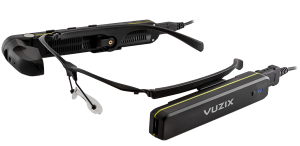
But first, let’s take a closer look at the technical details: Due to the “floating display”, the display of the Vuzix M300 looks like a 5 inch smartphone display, which is viewed from a perceived distance of approx. 35 cm. The display can also be mounted either on the right or left side of the glasses mount.
Inside, a dual-core Intel Atom chip works together with 2GB RAM and 64GB flash memory. Interaction with the glasses is either via the built-in voice recognition or via the touchpad on the side of the main unit. Head movement can also be tracked via built-in sensors. For things like QR code scanning, image tracking or simple picture/video recording, the M300 features a 10 megapixel/1080p camera on the front with autofocus and image stabilisation.
Standard connectivity options such as MicroUSB, Wifi or Bluetooth are also supported by the glasses. One of the problems of the predecessor mentioned at the beginning is the battery life. Vuzix has cleverly solved this problem with the M300. Small 860 mAh batteries can be easily replaced during operation. An integrated 160 mAh battery provides interim power during swapping. In addition, the glasses can be equipped with some extensions from Vuzix, among which an additional 9000 mAh battery can be found. At €449, the Vuzix M400 is one of the most affordable smart glasses on the market.
Our opinion:
One of the biggest advantages of the Vuzix M300 is its weight. It is very light and can be worn comfortably for several hours. The disadvantage, however, is that the focus on its light weight has neglected its robustness. The model is very fragile and therefore not ideally suited for industrial environments.
Industrial suitability
Operation
Battery life
Weight
Display
Price
◼◻◻◻◻
◼◼◼◼◻
◼◼◼◻◻
◼◼◼◼◻
◼◼◻◻◻
◼◼◼◼◼
Vuzix M400
Compared to its predecessor model, the Vuzix M300, the battery life of the Vuzix M400 has again increased greatly and is now over 5 hours. The internal battery supports hot-swapping of external batteries, which can extend the operating time of the glasses. There are three connectors on the front and back.
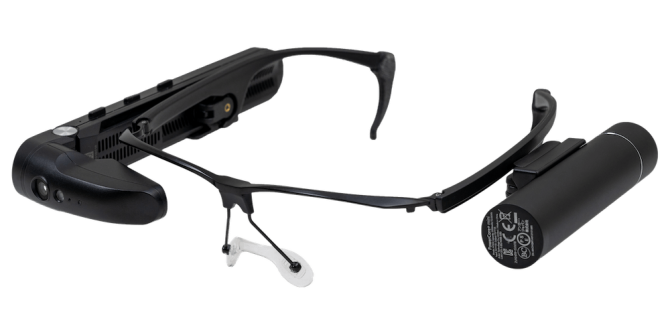
The front connector can be seen as a unique selling point. The plugs on the back are for the camera unit and the battery charging cable. This means that the glasses are still fully operational even if they are used for a longer period of time. With a price of €1,799, the Vuzix M400 is a lot more expensive than the M300, but it also has a lot more to offer.
Our opinion:
The Vuzix M400 is drop-, water- and dust-resistant, which makes it a data goggle suitable for industrial use. At 180 grams, it is only 30 grams heavier than its predecessor and thus offers high wearing comfort in addition to robustness. Loud noises in an industrial environment are filtered out via noise suppression in the microphone.
Industrial suitability
Operation
Battery life
Weight
Display
Price
◼◼◼◼◼
◼◼◼◼◻
◼◼◼◼◻
◼◼◼◼◻
◼◼◻◻◻
◼◼◻◻◻
Vuzix Blade
The latest model from Vuzix has already attracted quite a bit of attention, not only because of its design, but the Vuzix Blade already comes dangerously close to the optics of normal glasses. Although at first glance it looks as if these are binocular glasses, all content on the Blade is only displayed on the right lens.

The device features a Quad Core ARM processor, an 8-megapixel/720p camera, expandable memory via a microSD slot, Bluetooth and WiFi.
One stand-out feature of the glasses is the voice recognition, as Amazon’s Alexa is directly integrated here. Of course, this automatically makes it possible to ask the glasses for information from the World Wide Web. More sensibly, however, this means that all Alexa-supported skills can be used here, which can be seen as a plus in the era of emerging chatbot solutions.
However, interaction besides voice input can also be done here via a touchpad on the side of the glasses. The glasses can be managed via the companion app available for iOS and Android smartphones, through which apps and settings can be adjusted. The Vuzix Blade is available from as little as €999.
Our opinion:
The Vuzix Blade comes surprisingly close to a normal pair of glasses and offers a high level of wearing comfort due to its size and weight. However, similar to the Vuzix M300, robustness has been left out of the Blade, which is why it is very fragile. It is neither drop, water nor dust resistant, which is why it is not suitable for industrial environments.
Industrial suitability
Operation
Battery life
Weight
Display
Price
◼◻◻◻◻
◼◼◼◻◻
◼◼◼◻◻
◼◼◼◼◼
◼◼◻◻◻
◼◼◼◼◻
Iristick.G1
The Iristick.Z1 was developed by a Belgian start-up specifically for use in industrial environments. It has a 5x optical zoom, allowing important individual elements to be viewed sharply at close range. The zoom function is particularly helpful when assisting a remote expert, who can use it to inspect small details from a distance as if he were standing right in front of it.
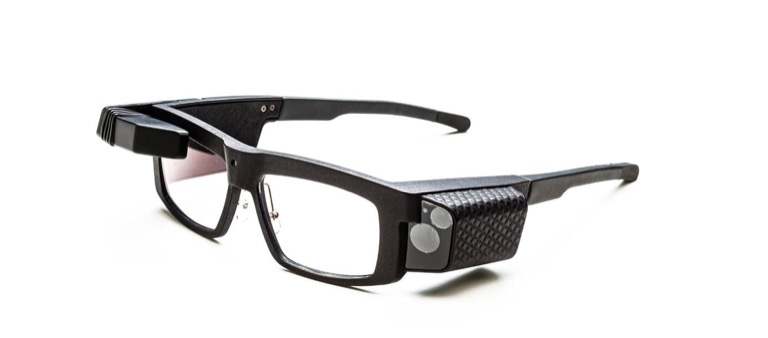
In addition, the model includes a built-in laser and flash LED, making it possible to read barcodes as small as 3 cm from a distance of 2 metres.
The Smart Glass can be operated via voice control, allowing industrial tasks to be performed hands-free. In addition to voice commands, the glasses also offer touchpad gesture control.
With a weight of 62 grams, it is one of the lightest smart glasses on the market. Unlike most smart glasses in this weight class, ruggedness has been taken into account with this model, making it an industrial-grade pair of glasses.
Our opinion:
Iristick has tried to bring a pair of glasses to the market that is not only light and comfortable, but also extremely stable and robust. In our opinion, the young start-up has succeeded very well at first glance. However, due to the relatively short time on the market, we cannot yet give a detailed recommendation and must test the glasses more intensively in rough industrial environments.
Industrial suitability
Operation
Battery life
Weight
Display
◼◼◼◼◻
◼◼◼◼◻
◼◼◼◻◻
◼◼◼◼◼
◼◼◼◻◻
Realwear HMT-1
In 2017, Realwear introduced the HMT-1. An extremely robust pair of data glasses that is controlled by voice commands and works perfectly even in noisy industrial environments (up to 95dB). With the voice control, Realwear relies on a completely different form of interaction than the other data glasses – because it manages completely without a control panel. This is a very sensible step, especially for field service. Hands-free operation allows tasks to be carried out more quickly and safely.
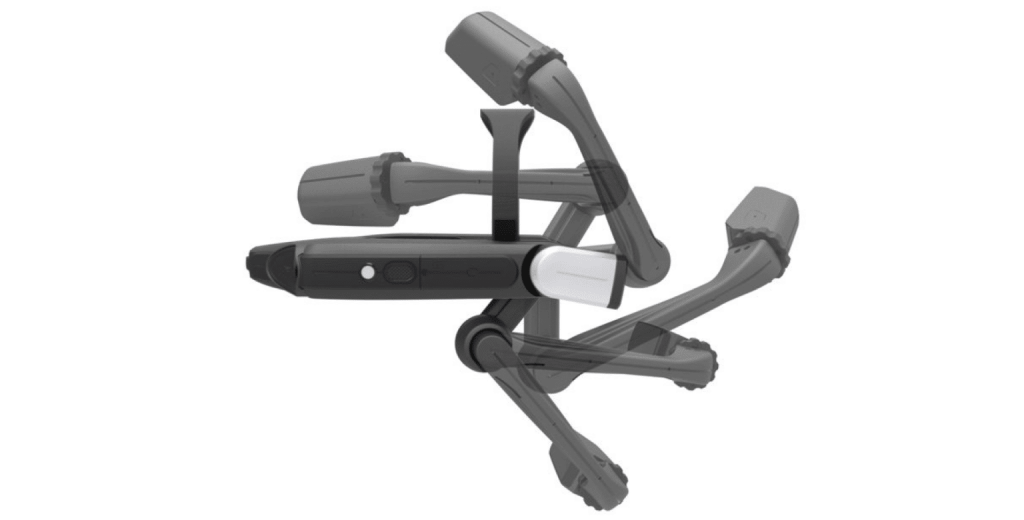
The IP66 protection class protects the data goggles from water and they are dustproof. Due to the robust, shock-resistant construction, the goggles can be used in temperatures from -20°C to +50°C. At full power, the battery lasts at least 5 hours – but it is also flexibly replaceable and can be changed during operation. The display integrated in the headset, as well as a scanner and a 16-megapixel camera, reliably help to record data. Features such as WLAN, Bluetooth and GPS make the HMT-1 the perfect assistant for sending and receiving data as well as maintenance instructions and remote support. The industrial-grade wearable can be combined with safety helmets and goggles, making the HMT-1 ideal for use in noisy industrial environments. For €1,877, the HMT-1 is an extremely robust and industrial-grade data goggle.
Our opinion:
The Realwear HMT-1 has been specially developed for industrial use and offers a very high level of robustness. In addition, it has a voice recognition system that is one of the best on the market today. This makes it possible to work hands-free on a machine or plant without any problems. In combination with a safety helmet and safety goggles, it offers the best conditions for use in industrial environments.
Industrial suitability
Operation
Battery life
Weight
Display
Price
◼◼◼◼◼
◼◼◼◼◼
◼◼◼◼◼
◼◼◼◻◻
◼◼◼◼◻
◼◼◻◻◻
Realwear HMT-1Z1
The HMT-1Z1 is the explosion-proof version of the HMT-1 and is particularly suitable for use in the chemical industry. It is thus the world’s first intuitive and completely hands-free Head Mounted Tablet (HMT) for use in hazardous areas 1/21 or CSA Class I, II, III Division 1. This means that there is no risk of ignition when hazardous areas are present during normal routine operation.
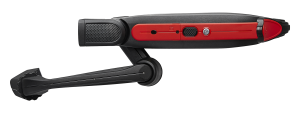
Externally, the HMT-1Z1 differs only in its red signal colour. Just like the HMT-1, it is an extremely robust pair of data glasses that is operated entirely by voice control. Together with the HMT-1, its functions make it part of the more comprehensive Smart Glass. Those who need explosion-proof data glasses must be prepared to invest more, with a price of €4.700 for the HMT-1Z1.
Our opinion:
In addition to the advantages also offered by the HMT-1, the additional explosion protection makes the HMT-1Z1 a top performer. It can be used in completely every industrial sector, including chemistry, without any problems. However, its price is correspondingly higher. So anyone who does not need explosion protection is very well equipped with the HMT-1.
Industrial suitability
Operation
Battery life
Weight
Display
Price
◼◼◼◼◼
◼◼◼◼◼
◼◼◼◼◼
◼◼◼◻◻
◼◼◼◼◻
◼◻◻◻◻
Models with monocular display
Epson Moverio BT-300
With the Moverio BT-300, Epson has created the lightest semi-transparent multimedia glasses with Si-OLED display. Weighing only 69 grams, they offer a wearing comfort similar to that of normal glasses. The Moverio BT-300 uses Si-OLEDs (Organic Light Emitting Diode), a silicon-based display technology developed by Epson, to deliver particularly high-contrast and sharp images.
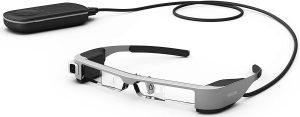
Unfortunately, only remaining models of the BT300 for 790€ are still available. It is no longer officially available on the market. But Epson is already working on the fourth generation of the Moverio series and has launched two versions, the Moverio BT-40 and BT-40S.
Our opinion:
The Epson Moverio BT-300 is one of the low-priced smart glasses – but it also offers only average quality. The battery life of 5 hours is sufficient, but not outstanding either. The accompanying controller and the high fragility make use in industrial environments difficult.
Industrial suitability
Operation
Battery life
Weight
Display
Price
◼◼◻◻◻
◼◼◻◻◻
◼◼◼◻◻
◼◼◼◼◻
◼◼◻◻◻
◼◼◼◼◻
Epson Moverio BT-350
Before we get to the successor to the BT-300, let’s take a look at the Moverio BT-350, a binocular smart glass from the Epson family that has become slimmer and lighter over the years, from the BT-100 to the BT-200, and now weighs in at 119g. The technical specifications include a quad-core Intel Atom processor running at 1.44 GHz along with 2 GB of RAM and 16 GB of internal memory, but this can be expanded via the built-in MicroSD slot.
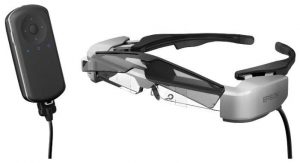
The glasses are not entirely wireless. As all the computing power is built into the connected control unit, which of course has a positive effect on the weight of the glasses. The control unit has a touchpad, standard Android navigation buttons and a directional button, making it the main input device as well.
.Both the glasses and the control unit have a gyroscope and an accelerometer built in. Compass, GPS and light sensor are also present in the device as well as Wifi and Bluetooth connectivity. The Moverio BT-350 has a camera on the front of the headset with a 5 MP resolution. One of the main problems with smartglasses is their usability for people who wear glasses. This is solved here with insertable optical lenses or a replaceable, larger nose clip.
Our opinion:
The Epson Moverio BT-350 is also operated via an external control unit, which means that the employee never has his hands free during use. Service use in an industrial environment is more difficult.
Industrial suitability
Operation
Battery life
Weight
Display
Price
◼◼◻◻◻
◼◼◻◻◻
◼◼◼◻◻
◼◼◼◼◻
◼◼◻◻◻
◼◼◼◼◻
Epson Moverio BT-40 und BT-40s
With the Moverio BT-40 and the Moverio-BT-40s, the Japanese manufacturer brought two new versions of its Smartglass onto the market in December 2020. The new models work with a full HD resolution. Compared to the predecessor, the field of view has been enlarged to 34 degrees. This corresponds to a view of a 120-inch screen from a distance of five metres. In addition, the glasses feature a new design and improved connectivity. An individually adjustable and comfortable frame ensures a high level of comfort. External devices can be connected via USB Type-C.
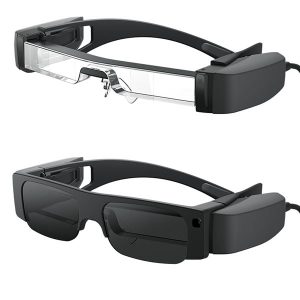
The two versions differ in their operating system. As with the BT-300, the BT-40s still relies on an integrated touchpad, which makes it easy for users to operate the data glasses without a long introduction. The touchpad can be stowed in the breast pocket during a conference or a repair, for example, so that both hands are completely free for other activities. Especially in the industrial environment, this creates a high added value.
The BT-40, on the other hand, functions like an external monitor or projector that can be connected to and controlled by one’s own smartphone, tablet or PC. This means that one is still dependent on an external terminal device here.
Our opinion:
The BT-40 is not a stand-alone data goggle, but only works in conjunction with another terminal device, which is why it is not suitable for industrial use for us. The BT-40s is also controlled via an integrated touchpad, but it is much more robust than the BT-300.
Industrial suitability
Operation
Battery life
Weight
Display
Price
◼◼◼◻◻
◼◼◻◻◻
◼◼◼◻◻
◼◼◼◼◻
◼◼◼◻◻
◼◼◼◻◻
Hololens 1. Generation
Another well-known smartglass is the HoloLens from Microsoft. It is the world’s first fully holographic computer. It is fundamentally related to smartglasses like the one from Epson, because it also extends our reality with additional information. However, digital information is not displayed on a flat screen that floats in front of the eye, but is placed in real space in the form of mixed reality with a realistic appearance.
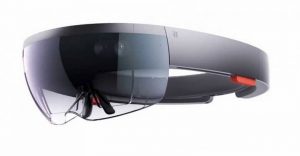
The HoloLens includes various control components: Gaze, gesture control, alternative control via clicker and a voice control. With HoloLens 2, gaze capture was added as a technical function. Gaze is a fixed point in the middle of the field of vision that can be controlled with head movement – not via eye tracking, as the term suggests.
Our opinion:
As far as wearing comfort is concerned, the model still takes a lot of getting used to. Microsoft has improved this somewhat with the HoloLens 2. Due to the currently still quite high price (approx. 3500 USD) and also the lack of robustness, very weak battery life and the size, it is not suitable for industrial use and cannot keep up with the other smart glasses on the market for use in remote service.
Industrial suitability
Operation
Battery life
Weight
Display
Price
◼◻◻◻◻
◼◼◻◻◻
◼◻◻◻◻
◼◼◻◻◻
◼◼◻◻◻
◼◼◼◻◻
Hololens 2. Generation
After the Hololens 1, Microsoft worked on a further development and brought the Hololens 2 onto the market a year ago. This has been improved by greatly enlarging the field of vision, making it much better at displaying holograms and other 3D images. The size of the glasses remains the same as its predecessor, but Microsoft has managed to reduce the weight slightly – from 579 to 566 grams.
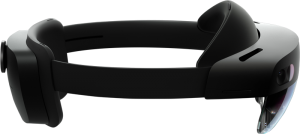
The new balance shift, however, makes wearing them for more than 5 minutes much less painful. The data goggles continue to do without operating elements and, in addition to recognising hand gestures, also rely on voice control, so that both hands always remain free for working on the machine. An eye tracking API is used for eye tracking, which was designed with data protection in mind. This means that the glasses do not transmit any information, such as biometrics, which would be essential for identifying an individual. In order for eye tracking to work, a calibration has to be done beforehand. During this process, the user is shown a certain number of holographic targets that need to be looked at.
Due to difficult lighting conditions caused by the heavily darkened lenses, the mixed reality glasses make the work enormously more difficult. Due to their comparably heavy weight, they also do not offer users any wearing comfort. With a battery life of just two hours, it also does not offer reliable use over an entire working day.
Our opinion:
Despite its advances, we do not consider Hololens suitable for our application area, at least as it stands today. Due to its high sensitivity, it is ideal for indoor use, e.g. in healthcare, but not for rough industrial use.
Industrial suitability
Operation
Battery life
Weight
Display
Price
◼◻◻◻◻
◼◼◼◻◻
◼◻◻◻◻
◼◼◻◻◻
◼◼◼◻◻
◼◼◻◻◻
Conclusion: Realwear still our number one
The HMT-1 still ranks first in terms of robustness and user-friendliness. It is insensitive to dust, dirt and falls from a height of up to two metres onto concrete. Fully functional in extreme cold or heat (from -20°C to 50°C) and waterproof with an IP rating of 66, these data goggles are especially suited for use in industrial service. The HMT-1 is also the undisputed leader in our sales figures.
Which smart glass you ultimately choose, however, also depends heavily on the particular use case, but also on individual preferences. Some use cases require binocular displays to provide information to the user. Other use cases require an unrestricted view of the machine or system, for which the monocular display is recommended.
We would be happy to advise you personally and introduce you to the different smart glasses.
